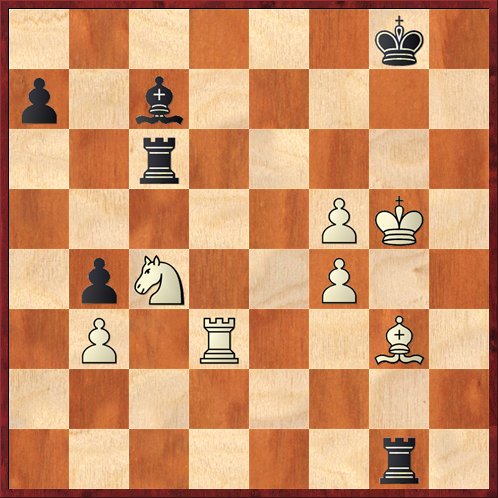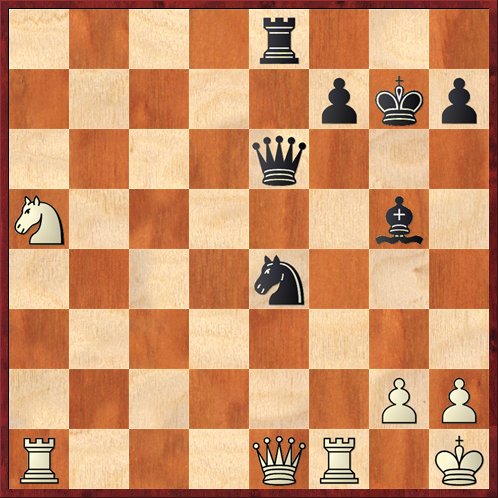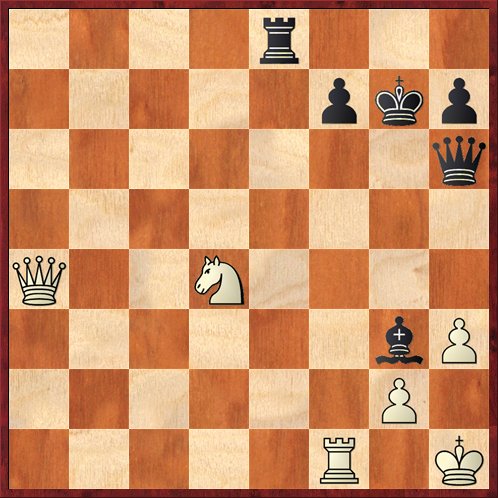I didn’t catch very much of the action on Day 4 of the World Cup, because I had other commitments, but I did steal a glance at it now and then. Today was very nearly a whitewash for the higher-rated players. Out of 32 games, only one lower-rated player was able to win. That was Julio Granda Zuniga (#50) against Peter Leko (#15). Leko seems to be vulnerable in this kind of tournament; he went out even earlier (round 1!) in the last World Cup.
Even though there was only one full-point upset, there were a lot of draws, and that means there are still lots of chances for lower-rated players to win their matches with an upset tomorrow. In all, there were 20 draws, and 11 games won by the favorites. Almost all of them were games where the favorites had White. The only games won by Black in this round were by #19 Ivanchuk against #83 Robson and #23 Vachier-Legrave against #87 Ortiz Suarez.
For any of you who saw the discussion of Alekseev-Adhiban in my last post, here was the position:
FEN: 8/1p4B1/2p5/2P1p3/pP6/k2K4/8/8 w – – 0 1
Here Alekseev’s flag fell, presumably as he was playing 61. Kc3 (although since he didn’t complete the move, the official record doesn’t show this). I wrote in my last entry that I thought White was still winning, but reader Panu Helke correctly pointed out that it’s a draw after 61. … e4! You can see his analysis in the comment to my last post. The only thing I would add to it is that if 62. Bh6 Ka2 63. Kc2, Black simply moves his king back to a3. If White plays 64. Kc3 a repetition ensues, and if White plays 64. Bd2 then the deflection 64. … e3 is good, and in fact, I think that simply 64. … Ka2 also works. It’s funny that after 64. … Ka2 65. Bc1, both pawn advances (… a3 and … e3) are bad, and yet White is curiously paralyzed by the threat of those advances later on.
By the way, as Helke points out, Alekseev could have gotten to exactly the same position but without the pawn on e5, and this of course would have been winning for him, by a zugzwang maneuver that readers might want to work out for themselves.
There was another “tragic ending” today, though not quite as tragic as Alekseev’s. #53 seed Aleksey Dreev, as Black, got to this winning position against #12 Wang Hao:
FEN: 6k1/p1b5/2r5/5PK1/1pN2P2/1P1R2B1/8/6r1 b – – 0 1
Here, as Polgar and Trent pointed out in their commentary, 68. … a5 is winning. The idea is to play … a4 and … ab, and White will be forced to sacrifice his knight in order to stop the pawn from queening. With an extra rook Black should win routinely.
But Dreev played 68. … Bb6? and was stunned when Wang claimed a draw by threefold repetition after 69. Kh5! The claim was valid. Presumably Dreev did not realize he was repeating the position a third time because the in-between moves (between repetitions 1 and 2, and repetitions 2 and 3) had been different.
It’s an easy mistake to make, especially when there are less than 30 seconds left on your clock. (Both players were living on the 30-second increment by this point.) Beginners are sometimes not even aware of this fact: It’s only the position that has to repeat three times, not the exact sequence of moves.
There was one more favorite who dodged a bullet. Alexander Morozevich, as White, got to this position against Rafael Leitao:
FEN: 4r3/5pkp/4q3/N5b1/4n3/8/6PP/R3QR1K w – – 0 1
White is an exchange up, but faces huge practical problems because of Black’s kingside pressure and active pieces and because of the general lack of pawns on the board. In time pressure, Morozevich played 35. Qb4?? and the computer went crazy, suddenly showing Black with an 8-pawn advantage! Do you see what Morozevich missed?
If you don’t see it, don’t feel bad. Leitao missed it, too. The winning move is 35. … Ng3+!! White cannot decline the sacrifice with 36. Kg1 because 36. … Be3+ leads to mate. And after 36. hg Qh6+ 37. Kg1 Be3+ 38. Rf2 Bxf2+ 39. Kxf2 there is a neat final twist: 39. … Qf6+! forking the king and rook. After being an exchange down, Black ends up ahead by the exchange! And with White’s king so exposed, White can scarcely survive long.
Even though it’s a tricky combination, with the final point five moves deep, they’re all forcing moves, and the starting sacrifice (… Ng3+) is exactly the sort of move that Leitao has been working to set up. But when Morozevich simply handed him that opportunity on a silver platter, Leitao missed it!
Of course that wasn’t the end of this incredible and fascinating game. Leitao actually did manage to win one exchange (but not two) in the time scramble: 35. … Bf6?? 36. Rad1 Bc3 37. Qb5 Be5 38. Rd3 Rb8 39. Qa4 Qh6 40. h3 Ng3+ (Finally! And no sacrifice required!) After 41. Rxg3+ Bxg3 you would think that Black would be okay. He’s won back the exchange and the material is even, and with so few pawns left, how can White win?
Well, the computer shows White as +2 pawns (!) in this position, and Morozevich was up to the task. He played 42. Nc6! Re8 43. Nd4! reaching the second position I want to show you.
FEN: 4r3/5pkp/7q/8/Q2N4/6bP/6P1/5R1K b – – 0 9
So basically every Black piece is en prise here. The rook directly, and the queen and bishop indirectly because of the fork threat on f5. So what does Black do? He leaves the rook and bishop en prise and moves his queen to another square where it’s en prise! That’s right, he plays the mind-boggling 43. … Qf6!
Now Moro can’t take on e8 or f6 because of back-rank mates. He can’t play 44. Nf5+ because of 44. … Qxf5. So what does he do? Well, in this berserk position why not put one of your own pieces en prise? He played 44. Qb5!, offering the knight up for capture. A quadruple-threat move! He’s (1) protecting the rook on f1 (thereby (2) threatening to take the queen on f6), (3) keeping an eye on the e8 rook, and oh, by the way, (4) reestablishing the threat of Nf5+.
Amateurs have trouble even playing moves that do two things at once. GM’s make moves that do three or four things. Incredible.
Well, the game went on in this vein for about ten more moves, at which point Morozevich finally played a pseudo-queen sac to win a piece, and Leitao resigned. But I won’t show the rest here — you’ll have to look it up online.
It’s games like this that truly justify the time spent watching the World Cup. While the “tragedies” like Alekseev-Adhiban and Wang-Dreev show that the players are human and make mistakes that we all can relate to, the epic battles like Morozovich-Leitao make me feel as if the GM’s are playing a different game than what you or I play.







{ 4 comments… read them below or add one }
There was a bit of a “discussion” between the players and the arbiters when Wang Hao claimed the draw as the claim was not made in accordance with Article 9.2(a).
I think Wang Hao did not write the move before making the claim.
The arbiter then awarded Dreev 3min extra per Article 9.5(b) and the game continued.
Wang Hao recorded the move he wanted to make and made a new draw claim WITHOUT completing a move.
Dreev probably protested because 9.5(b) says in addition to the 3min penalty, the intended move must be made.
Wang Hao did not claim the draw correctly.
Yes, I saw this discussion as it was taking place. What was the arbiter’s reason for upholding the claim after Wang recorded the move? It makes the rule about writing your move down first seem moot.
On the other hand, I do agree that awarding the draw is the fairest decision — this business about you must write the move down first seems overly technical to me.
I think that MANY players on the amateur level do not know the correct procedure for claiming a draw by repetition, and in fact I gave a ChessLecture about this in the hope that I might save a listener a half-point some day. When I was much younger than now, I was once in a position just like Wang’s, where I played the move, stopped the clock and made the claim. This was the incorrect procedure, the claim was denied, and the game continued (and I eventually lost). In this case I had made multiple mistakes and it was quite appropriate that my claim was denied. First and foremost, I have no right to unilaterally stop both clocks. I need to be on move when I make the claim, because I am the one who should be at risk.
Study the rulebook! It’s worth it!
Some more insane action today. Kamsky’s game was both comic and tragic as both he and his opponent made blunder after blunder. In the space of one move, the position went from like -6 in the computer evaluation (in black/Kamsky’s favor) to +4 for white after Kamsky failed to find the right move. Amazing that he missed Qxh2+ in the middle game too. I think a lot of class A players would find it let alone a super-GM but he totally missed it.
An addendum on Morozevich-Leitao: Last night I showed the game to two masters who are friends of mine (Gjon Feinstein and Cliff Hart). Although they found the idea of 35. … Ng3+ fairly quickly, it took them at least 5 minutes to find the point of the combination, the fork 39. … Qf6+. I even told them, after about 2 minutes, to look for the “scorpion’s sting at the tail end of the combination,” as Fischer so memorably wrote.
When he finally found it, Gjon was really surprised that it had taken him so long, because all the moves are forcing moves (checks and captures) and he had identified the key positional ingredients, including the loose rook on a1. I have a hunch that, psychologically, … Qf6+ is hard to see because it’s a very long-range move — both the attack on the king and rook come from very far away — and so it doesn’t fit the mold of “closing in for the kill.”
Morals: 1) If you have time, don’t stop analyzing a line until you’ve gotten to the end of all the possible checks and captures.
2) It’s completely unfair to Leitao to criticize him for missing 35. … Ng3+. Don’t forget, he had just over a minute left. If you can’t see the whole combination in 60 seconds, maybe even in 30 seconds, then you’d better not play 35. … Ng3+, you’d better play something simple that keeps the initiative going. From that point of view, his move 35. … Bf6 was not a blunder at all.